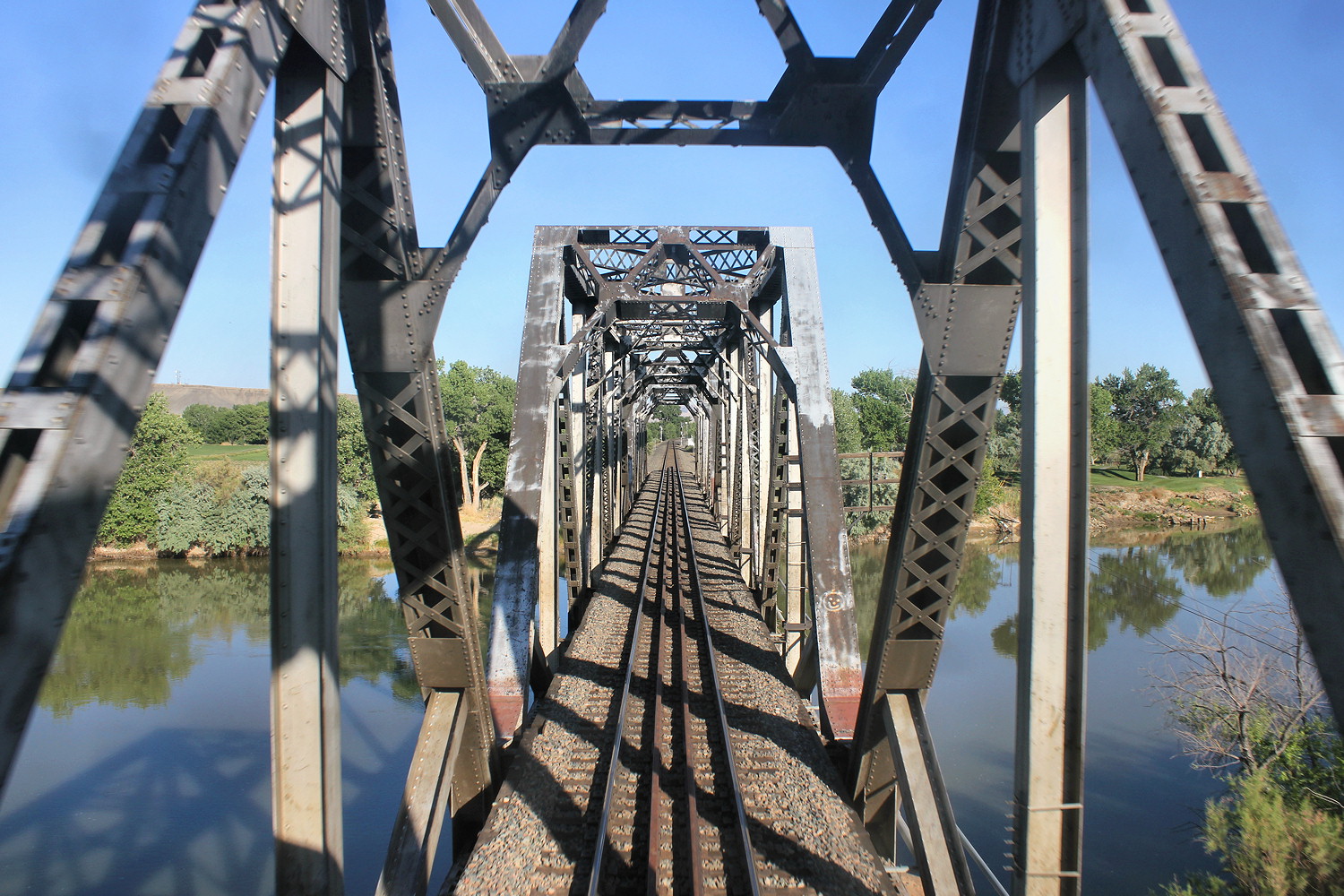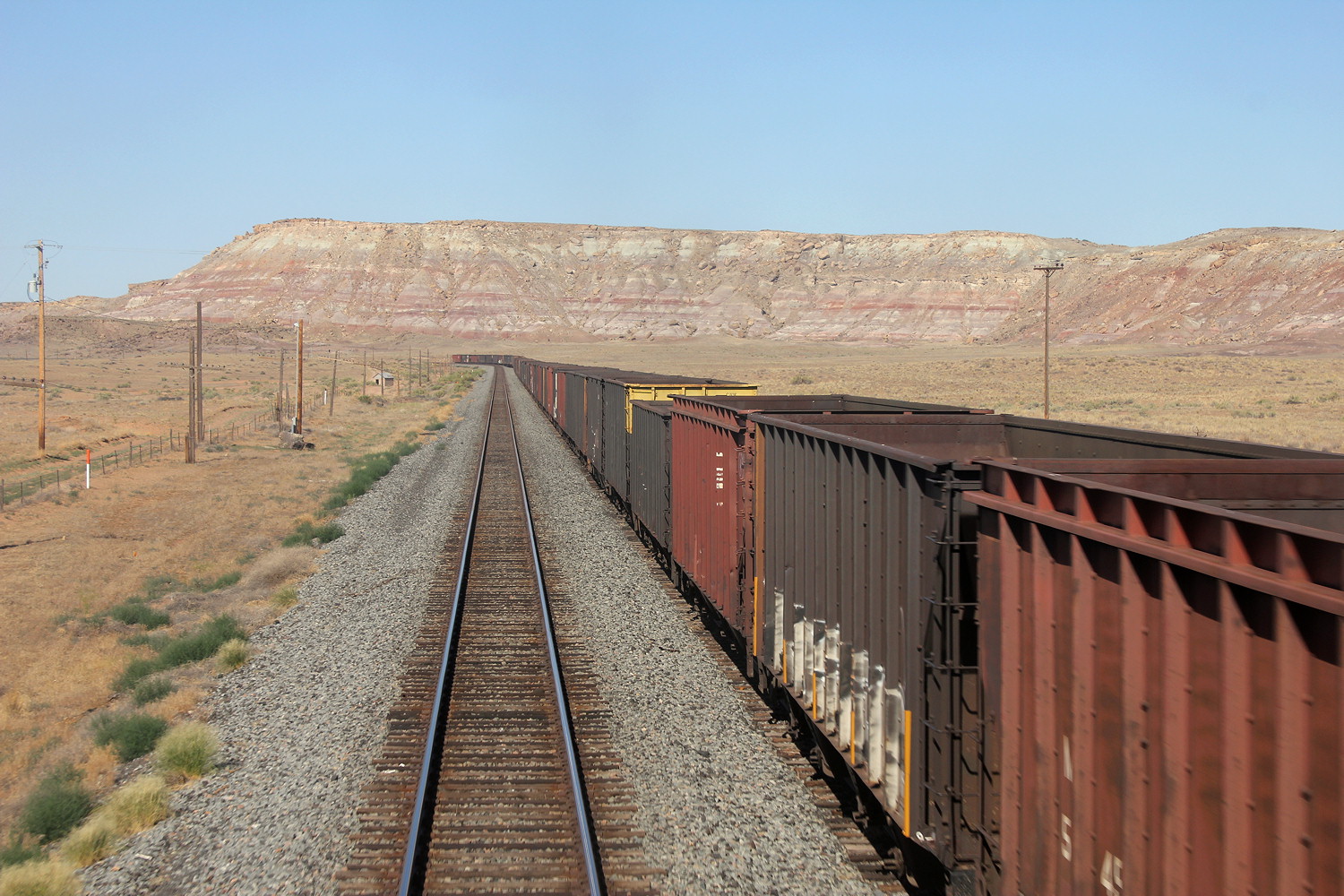You can locate all of this week's magical photos here and today more than ever I urge you all to check them out because this was easily the most scenic part of the trip.
This section of my Amtrak California Zephyr reprospective will be covering the segment from Helper, UT to Grand Junction, CO, which comprises the Union Pacific Green River Subdivision (see here which used to be part of the Denver, Rio Grande and Western main line between Pueblo, CO and Ogden, UT. Millage is marked from Pueblo, CO.
We begin approaching the Helper, UT Amtrak station where we find UP SD70M #4350 sitting in the yard there. If you couldn't guess Helper, UT is indeed a railroad town, founded as a helper base.
For all you road geeks here we see US 6 taking the short route through an escarpment while the railroad has to curve off and take the long way through.
If you thought Woodside on the LIRR was exciting, check out the DRG&W version of it. Like the UP Nevada Sub, the DRG&W main line is arranged in the typical Single Track with Passing Sidings setup commonly seen on North American railroad lines in rural areas. Sidings are about 5000 to 10,000 feet in length and located about every 4 to 8 miles along the line. Each end of the siding is controlled by a CTC interlocking grouped under a common name with the interlocking at the opposite end of the siding. This reflects the pre-CTC nomenclature where sidings were the functional elements in the Timetable and Train Order traffic management system as opposed to interlockings on modern lines. This whole line was in the process of being re-signaled in order to replace the ancient pole line and relay based interlocking hardware so it was a good thing that I got out on this trip to properly document the conditions. The CTC dates from the mid to late 1960's and despite the use of hooded traffic light signals, new Darth Vaders are going in anyway.
Every so often we would pass a point where it was clear that the RoW had been realigned. Here is one such point with the pole lines following the original route.
BNSF C44-9W #4446 waiting for us to pass on the VISTA siding.
Oh I just love this picture...its exactly what it says on the tin. The DRG&W sidings used to be of the restricted speed variety without track circuits. Entrance to the siding would be given by a R/Lunar signal. Later the sidings were upgraded to the signaled variety and the home signals were reworked to display either R/Y Diverging Approach or R/*Y* Diverging Approach Diverging.
Stored hopper cars on the SPHINX siding.
The Amtrak Green River, UT station which also doubles as a UP C&S base
Green River is aptly maned as there is a river and things are in fact green.
If there was one really cool thing about this line is was that the old school DRG&W defect detectors were still in service. Here we can see a High/Wide car detector that uses a thin wire around the clearance envelope that if snagged would pull a plug out of a socket and trigger a defect alarm, which in the case of the HCD consisted of a flashing blue light a few miles down the track. Also if you look between the tracks you can see a frangible dragging equipment detector. Instead of the paddle type used today, the older type would be either shattered or displaced by dragging equipment, again breaking a circuit. The DRG&W was absolutely paranoid about dragging equipment as nearly every intermediate signal was equipped with one. In the 170 miles of the Subdivision there are 32 DED's, an average of about 1 every 6 miles, compared with 12 combination hotbox/dragging equipment detectors, which I was not counting in the stand alone DED count. The stand alone DED's would only broadcast a radio message on defect.
While the UP did seem to be keeping the classic style DED in some of the re-signaled areas, there was also evidence that at least some would be replaced by the newer paddle type.
In what was probably the only good signaling news of the entire trip I noticed that UP was in the process of installing about 6 intermediate signal locations that were equipped with US&S model N-3 color light units instead of those bullshit Safetran clamshells. The N-3 is a single unit cast iron signal that was popular with railroads such as the C&O and can be seen on some unresignaled parts of the (7) Flushing Line. That silver paint on the back really makes the old girls look handsome. The units were probably recycled from elsewhere on the UP system.
Anybody up for some off roading?
Southern Pacific painted C44-9W sitting behind a UP unit on the Floy siding with a couple of cars of scrap metal
A pair of Whitcomb RS-4-TC industrial switchers numbered OHFX 1250 and 1258 wait at the end of the track at the Brendel Uranium tailings disposal site where long trains of hopper cars are brought with contaminated tailings from western Uranium mines.
Passing through Thompson, UT.
One of several High Water detectors on the line next to a new intermediate signal location with modern style dragging equipment detector paddle. As they say in the desert, when it rains it pours.
Another curve re-alignment at MP 505.
More stored coal cars on the AGATE siding.
At MP 486 we begin to run along side the mighty Colorado river with a massive sheer rock face on the other side of the tracks with an extra tall slide fence providing protection.
Stored cars at the UTLINE siding. Alcoholic beverage service can now be resumed.
When I said scenery overload I wasn't kidding.
It might not be very grand, but I think it counts as a canyon. Milepost 480.
West End SHALE siding. Simply magnificent.
Colorado at the RUBY siding.
This tunnel at MP 472 seems to remind me of that last city of Petra.
Approaching Grand Junction we pass the DRG&W station at Mack while a C&S truck heads off to deliver a new relay hut to the west end MACK interlocking.
Passing a local freight train on the Fruita siding.
Entering Grand Junction the line gets a second main track at DURHAM.
Entering the depot siding and passing a rare repeater signal for trains making station stops that don't have clear views of the actual siding interlocking signals.
Well this marks both the end of the Green River subdivision and today's photo set. Again there were a ton of great photos that were not featured today to I urge you all again to check out the full list at.
http://acm.jhu.edu/~sthurmovik/Railpics/12-06-14_UTAH/-Thumbnails.html






























Nice photos! We take the Zephyr once a year and this adds a new dimension to the journey
ReplyDelete